Community-led mangrove replanting initiatives
In a world increasingly affected by climate change, community-led initiatives have emerged as beacons of hope, uniting people around a common cause: the restoration of mangrove ecosystems. These vital coastal forests not only provide essential habitats for wildlife but also act as natural barriers against storms and erosion. Through collaborative efforts, communities are embracing the challenge of replanting mangroves, playing a pivotal role in environmental conservation while fostering stronger bonds among residents. Join us as we explore the joys and benefits of community-led mangrove replanting initiatives!
Discover the Joy of Community-Led Mangrove Replanting
Engaging in community-led mangrove replanting initiatives brings together individuals from all walks of life, united by a shared passion for the environment. Participants often describe a profound sense of fulfillment as they dig into the earth, plant seedlings, and watch their efforts grow into flourishing mangrove forests. These events foster social connections, as neighbors work side by side, sharing stories and laughter amid the beauty of nature. The collective spirit during these initiatives can transform a simple planting day into a memorable community celebration.
Additionally, these initiatives help educate participants about the importance of mangroves and their role in combating climate change. Workshops often accompany planting events, allowing community members to learn about the ecological benefits of mangroves, such as carbon sequestration and biodiversity support. This newfound knowledge empowers individuals to become advocates for their local environment, sparking a desire to protect and preserve their coastal ecosystems for future generations.
How Local Heroes are Restoring Coastal Ecosystems
Local heroes—often everyday citizens—are leading the charge in restoring coastal ecosystems through dedicated mangrove replanting efforts. These grassroots movements arise from the recognition that mangrove loss due to development, pollution, and climate change poses a significant threat to coastal communities. Inspired by their surroundings, many individuals band together to take action, often supported by local organizations, NGOs, and government initiatives. Their passion and commitment have resulted in remarkable success stories, turning barren shores into thriving mangrove habitats.
In these initiatives, local knowledge plays a crucial role. Community members possess a deep understanding of their ecosystem, including the best planting techniques and the most suitable species for their specific environment. Many initiatives involve the use of traditional ecological knowledge, ensuring that the methods employed are not only effective but also respectful of the natural processes in place. By harnessing this wisdom, communities can create resilient mangrove forests that will thrive in the face of future challenges.
Benefits of Mangrove Planting for Our Environment
Mangroves are often referred to as the "lungs of the coastline" due to their remarkable ability to sequester carbon dioxide, helping mitigate climate change. When communities engage in planting these trees, they are playing a crucial role in combating the global climate crisis. Additionally, mangroves serve as natural barriers against storm surges, protecting coastal communities from flooding and erosion. Their extensive root systems stabilize shorelines, reducing the impact of waves and ensuring the health of adjacent ecosystems.
Beyond climate resilience, mangroves are vital for biodiversity. They provide a rich habitat for various marine species, including fish, crabs, and birds. By restoring mangrove forests, communities help to boost local fisheries, which are often a primary source of livelihood for many coastal residents. The ecological benefits extend beyond just wildlife; healthy mangrove ecosystems also improve water quality by filtering pollutants and trapping sediments. Thus, community-led replanting initiatives contribute not just to environmental restoration but also to the well-being of local economies.
Join the Movement: Get Involved in Mangrove Projects!
If you’re inspired by the positive impact of community-led mangrove replanting initiatives, there are countless ways to get involved! Start by researching local organizations that focus on coastal restoration efforts. Many of these groups host regular planting events, workshops, and educational programs, providing ample opportunities for you to lend a hand. Whether you’re an experienced environmentalist or simply curious about the process, there’s a place for everyone in these uplifting efforts.
Moreover, consider advocating for mangrove conservation in your community. Share the importance of these ecosystems on social media, organize local clean-up days, or even reach out to local schools to inspire the next generation of environmental stewards. By spreading awareness and joining hands with fellow community members, you can help create a lasting positive impact on the environment while fostering a sense of unity and purpose in your area. Be the change you want to see—together, we can restore our precious mangrove forests!
Community-led mangrove replanting initiatives embody the spirit of collaboration and resilience, showcasing how individuals can come together to make a lasting difference for our planet. By nurturing these vital ecosystems, participants not only enhance their local environment but also strengthen community bonds and foster a shared commitment to conservation. As we embrace the joy of planting and restoring mangroves, let us remember that every seedling planted is a step toward a healthier, more sustainable future. Join the movement and be part of this inspiring journey today!


